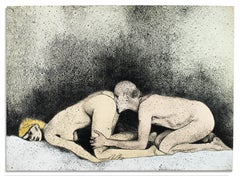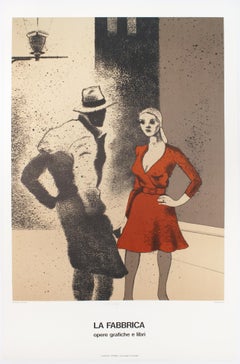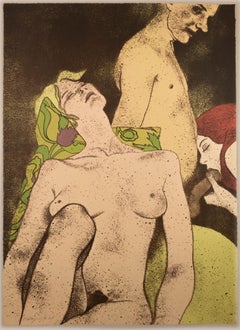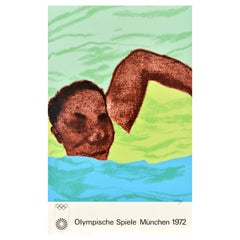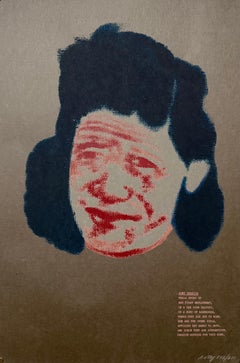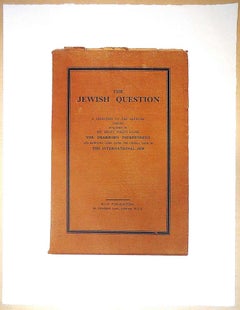Ronald Brooks Kitaj Art
American, 1932-2007
Born in Cleveland, Ohio in 1932, R.B. (Ronald Brooks) Kitaj is considered a key figure in European and American contemporary painting. While his work has been considered controversial, he is regarded as a master draftsman with a commitment to figurative art. His highly personal paintings and drawings reflect his deep interest in history; cultural, social and political ideologies; and issues of identity.
Among his various honors are election to the American Academy of Arts and Letters in 1982, and election to the Royal Academy in 1985 (the first American since John Singer Sargent to receive this honor.)
Numerous retrospective exhibitions of his work include shows at the Hirshhorn Museum in Washington, D.C.; The Jewish Museum, Berlin; The Jewish Museum, London; and the Hamburger Kunsthalle in Germany.
Raised in Cleveland, Ohio, and Troy, New York, Kitaj joined the Merchant Marines in 1949.
In 1950, between sailings, he attended classes at the Cooper Union for the Advancement of Science and Art in New York. He went on to study drawing at the Academy of Fine Art in Vienna, Austria.
Kitaj moved to Oxford, England in 1957, and enrolled at The Ruskin School of Drawing and Fine Art, University of Oxford.
In 1959, Kitaj was accepted into Royal College of Art, London, where he befriended classmate David Hockney. Upon graduation from the RCA, Kitaj signed with Marlborough Fine Art, London, where he had his first solo exhibition in 1963. His art career began in earnest, and he found critical acclaim alongside commercial success.
A second solo show followed at Marlborough Gallery, New York, in 1965, and he sold “The Ohio Gang” to The Museum of Modern Art.
In 1969, Kitaj taught for a year at the University of California, Los Angeles.
In 1976, he coined the term “School of London” in an essay he wrote as curator of the polemical exhibition, “The Human Clay,” at the Hayward Gallery, London. The term, though loose, continues to define a group of stylistically diverse artists, including Kitaj, who were working in London at that time focusing on figural representation.
In 1981, he spent a year in Paris, France, where he focused on drawing and use of pastel.
In 1994, the Tate Gallery, London, organized a major retrospective of Kitaj’s work. Hostile and personal attacks from some critics led to what Kitaj referred to as the “Tate War.” The exhibition subsequently traveled to the Los Angeles County Museum of Art and the Metropolitan Museum of Art, New York.
Kitaj moved to Los Angeles, California, and continued to exhibit with Marlborough Fine Art and the Marlborough Gallery, New York.
In 2001 the National Gallery London organized a solo exhibition of paintings: “R.B. Kitaj In the Aura of Cezanne and Other Masters.” Kitaj focused on his “late style” in his Yellow Studio in Westwood and died in 2007.
His gift of his archive to the UCLA Library Special Collections was celebrated with exhibitions at the Skirball Cultural Center and UCLA’s Young Research Library.to
1
38
3
41
33
25
8
2
2
1
Some do not (A) R.B. Kitaj erotic nude drawing of nude blonde with man on bed
By Ronald Brooks Kitaj
Located in New York, NY
An erotic dalliance between a nude blonde woman lying down, and nude man, on a bed with white sheets. Subtle shades of peach, tan, yellow, and grey and black shadow behind the couple...
Category
1970s Realist Ronald Brooks Kitaj Art
Materials
Lithograph
Vintage SIGNED Kitaj Poster, La Fabbrica, Milan (A Life 1975) woman in red dress
By Ronald Brooks Kitaj
Located in New York, NY
Printed in 1975, this poster features the encounter between an alluring woman dressed in red, and a man with his back to the viewer. The light of a streetlamp is beautifully imitated...
Category
Late 20th Century Modern Ronald Brooks Kitaj Art
Materials
Lithograph
A Rash Act: erotic drawing of nude blonde, redhead, and man with art deco motifs
By Ronald Brooks Kitaj
Located in New York, NY
A colorful erotic daydream drawing of a nude blonde fantasizing, with a redhead woman, and man. Green and purple patterns on hair and pillows, and art deco motifs, adorn this sensual...
Category
1970s Realist Ronald Brooks Kitaj Art
Materials
Lithograph
Original Vintage Sport Poster Munich Summer Olympics 1972 Swimming RB Kitaj
By Ronald Brooks Kitaj
Located in London, GB
Original vintage sports poster for the 1972 Summer Olympics in Munich - Olympische Spiele Munchen - designed by the painter and printmaker Kitaj (Ronald Brooks Kitaj; 1932-2007) depi...
Category
1970s German Vintage Ronald Brooks Kitaj Art
Materials
Paper
British Pop Art Artist RB Kitaj Screenprint Day Book Serigraph Silkscreen Signed
By Ronald Brooks Kitaj
Located in Surfside, FL
R.B. Kitaj (British American 1932-2007)
Hand signed and numbered
Screenprint
Measures approximately 24.5 X 16.65 inches
This is from the Robert Creeley daybook. They were done in ...
Category
1970s Pop Art Ronald Brooks Kitaj Art
Materials
Screen
R.B. Kitaj "The Jerwish Question"
By Ronald Brooks Kitaj
Located in Surfside, FL
Initialled signed in pencil From R. B. Kitaj, In Our Time: Covers for a Small Library After the Life for the Most Part, screenprint 1969 edition of 150 photo screenprint. A cover of ...
Category
1960s Pop Art Ronald Brooks Kitaj Art
Materials
Screen
British Pop Art Artist RB Kitaj Screenprint Day Book Serigraph Silkscreen Signed
By Ronald Brooks Kitaj
Located in Surfside, FL
R.B. Kitaj (British American 1932-2007)
Hand signed and numbered
Screenprint
This is from the Robert Creeley daybook. They were done in a variety of mixed media including serigraph, ...
Category
1970s Pop Art Ronald Brooks Kitaj Art
Materials
Screen
British Pop Art Artist RB Kitaj Screenprint Day Book Serigraph Silkscreen Signed
By Ronald Brooks Kitaj
Located in Surfside, FL
R.B. Kitaj (British American 1932-2007)
Hand signed and numbered
Screenprint
Measures approximately 24.5 X 16.65 inches
This is from the Robert Creeley daybook. They were done in ...
Category
1970s Pop Art Ronald Brooks Kitaj Art
Materials
Screen
Nude Sculpture R.B. Kitaj drawing of nude woman on handmade orange paper print
By Ronald Brooks Kitaj
Located in New York, NY
Here Kitaj depicts a sculpture of a nude woman, shaded delicately in black, printed on wonderfully textured handmade muted orange paper. The woman’s hand reaches to the inside of her...
Category
Late 20th Century Modern Ronald Brooks Kitaj Art
Materials
Lithograph
POGANY rare 17 color 1960s British Pop silkscreen signed numbered edition of 70
By Ronald Brooks Kitaj
Located in New York, NY
R.B. Kitaj
POGANY, 1966
17 colour Screenprint and Photo-screenprint
24 × 36 inches
Pencil signed and numbered from the Limited Edition of 70
Hand-signed by artist, Signed & numbered ...
Category
1960s Pop Art Ronald Brooks Kitaj Art
Materials
Screen, Pencil
British Pop Art Artist RB Kitaj Screenprint Day Book Serigraph Silkscreen Signed
By Ronald Brooks Kitaj
Located in Surfside, FL
R.B. Kitaj (British American 1932-2007)
Hand signed and numbered
Screenprint
This is from the Robert Creeley daybook. They were done in a variety of mixed media including serigraph, ...
Category
1970s Pop Art Ronald Brooks Kitaj Art
Materials
Screen
British Pop Art Artist RB Kitaj Screenprint Day Book Serigraph Silkscreen Signed
By Ronald Brooks Kitaj
Located in Surfside, FL
R.B. Kitaj (British American 1932-2007)
Hand signed and numbered
Screenprint
This is from the Robert Creeley daybook. They were done in a variety of mixed media including serigraph, ...
Category
1970s Pop Art Ronald Brooks Kitaj Art
Materials
Screen
Swimmer - Screenprint (Olympic Games Munich 1972)
By Ronald Brooks Kitaj
Located in Paris, IDF
Ronard Brooks KITAJ
Swimmer
Screen print
Signature printed in the plate
On heavy paper 101 x 64 cm (c. 40 x 26 inch)
Made for the Olympic Games in Munich, 1972
Excellent condition
Category
1970s American Modern Ronald Brooks Kitaj Art
Materials
Screen
Dominie in Catalonia, Kitaj drawing black white portrait of young girl with hat
By Ronald Brooks Kitaj
Located in New York, NY
This hand-drawn black and white portrait of Dominie, Kitaj’s adopted daughter, is one of the few etchings produced by the artist. The shape of Dominie’s wide sunhat and its patterned...
Category
Late 20th Century Ronald Brooks Kitaj Art
Materials
Etching
A Life (B) R.B. Kitaj Film noir night city scene of woman in red dress
By Ronald Brooks Kitaj
Located in New York, NY
Signed by the artist and numbered 49/50 lower left in pencil. Color lithograph on mauve Wookey Hole handmade waterleaf paper.
This print features the encounter between an alluring ...
Category
Late 20th Century Expressionist Ronald Brooks Kitaj Art
Materials
Lithograph
BAGHDAD Six color screenprint, renowned British Pop pioneer R.B. Kitaj, Signed/N
By Ronald Brooks Kitaj
Located in New York, NY
Ronald Brooks (R.B.) Kitaj
BAGHDAD, 1972
Six Color Screenprint and Photoscreenprint
20 × 14 1/2 inches
Pencil signed and numbered 1/125
Printed at Kelpra Studio, London
Published by ...
Category
1970s Pop Art Ronald Brooks Kitaj Art
Materials
Screen
R.B. Kitaj, Civic Virtue All Over The Floor, 53/100, Screenprint, 1967
By Ronald Brooks Kitaj
Located in San Francisco, CA
ABOUT
R.B. Kitaj, Civic Virtue All Over The Floor
Screenprint, Serigraphy.
Edition of 100. 53/100.
Signed in pencil lower left.
Unframed.
CREATOR R.B. Kitaj, United Kingdom. ...
Category
Mid-20th Century British Folk Art Ronald Brooks Kitaj Art
Materials
Paper
R.B. Kitaj Orgasm: drawing of woman in ecstasy with pale pink and clay red
By Ronald Brooks Kitaj
Located in New York, NY
Printed in a rich terra cotta red on pale pink paper, Orgasm depicts a woman’s head in profile with a dark background. Kitaj was fascinated with the female form, often producing edgy...
Category
Late 20th Century Realist Ronald Brooks Kitaj Art
Materials
Lithograph
British Pop Art Artist RB Kitaj Screen Print on Acetate Serigraph Signed
By Ronald Brooks Kitaj
Located in Surfside, FL
R.B. Kitaj (British American 1932-2007)
Hand signed and numbered
Screenprint
Measures approximately 24.5 X 16.65 inches
This is from the Robert Creeley daybook. They were done in ...
Category
1970s Pop Art Ronald Brooks Kitaj Art
Materials
Screen
R.B. Kitaj, Portrait, 13/70 Color Silkscreen 1970-1974
By Ronald Brooks Kitaj
Located in San Francisco, CA
ABOUT
R.B. Kitaj, Portrait, Edition of 70, Color silkscreen. Signed and numbered 13/70 in pencil upper right. Unframed.
CREATOR R.B. Kitaj, United Kingdom and USA.
DATE O...
Category
Mid-20th Century British Folk Art Ronald Brooks Kitaj Art
Materials
Paper
R.B. Kitaj, The Adding Machine, 63/70 Screenprint 1972
By Ronald Brooks Kitaj
Located in San Francisco, CA
ABOUT
R.B. Kitaj, The Adding Machine, Edition of 70, Signed and numbered 63/70 in pencil lower right. Unframed. Printed by Kelpra Studios, London, with their ink stamp on the back.
...
Category
Mid-20th Century British Folk Art Ronald Brooks Kitaj Art
Materials
Paper
British Pop Art Artist RB Kitaj Screenprint Day Book Serigraph Silkscreen Signed
By Ronald Brooks Kitaj
Located in Surfside, FL
R.B. Kitaj (British American 1932-2007)
Hand signed and numbered
Screenprint
Measures approximately 24.5 X 16.65 inches
This is from the Robert Creeley daybook. They were done in ...
Category
1970s Pop Art Ronald Brooks Kitaj Art
Materials
Screen
British Pop Art Artist RB Kitaj Screenprint Day Book Serigraph Silkscreen Signed
By Ronald Brooks Kitaj
Located in Surfside, FL
R.B. Kitaj (British American 1932-2007)
Hand signed and numbered
Screenprint
This is from the Robert Creeley daybook. They were done in a variety of mixed media including serigraph, ...
Category
1970s Pop Art Ronald Brooks Kitaj Art
Materials
Screen
British Pop Art Artist RB Kitaj Screenprint Day Book Serigraph Silkscreen Signed
By Ronald Brooks Kitaj
Located in Surfside, FL
R.B. Kitaj (British American 1932-2007)
Hand signed and numbered
Screenprint
Measures approximately 24.5 X 16.65 inches
This is from the Robert Creeley daybook. They were done in ...
Category
1970s Pop Art Ronald Brooks Kitaj Art
Materials
Screen
British Pop Art Artist RB Kitaj Day Book Mourlot Lithograph Jim Dine Signed
By Ronald Brooks Kitaj
Located in Surfside, FL
R.B. Kitaj (British American 1932-2007)
Hand signed and numbered
Screenprint
This is from the Robert Creeley daybook. They were done in a variety of mixed media including serigraph, ...
Category
1970s Pop Art Ronald Brooks Kitaj Art
Materials
Screen
British Pop Art Artist RB Kitaj Screenprint Day Book Serigraph Silkscreen Signed
By Ronald Brooks Kitaj
Located in Surfside, FL
R.B. Kitaj (British American 1932-2007)
Hand signed and numbered
Screenprint
Measures approximately 24.5 X 16.65 inches
This is from the Robert Creeley daybook. They were done in ...
Category
1970s Pop Art Ronald Brooks Kitaj Art
Materials
Screen
British Pop Art Artist RB Kitaj Screenprint Day Book Serigraph Silkscreen Signed
By Ronald Brooks Kitaj
Located in Surfside, FL
R.B. Kitaj (British American 1932-2007)
Hand signed and numbered
Screenprint
Measures approximately 24.5 X 16.65 inches
This is from the Robert Creeley daybook. They were done in ...
Category
1970s Pop Art Ronald Brooks Kitaj Art
Materials
Screen
British Pop Art Artist RB Kitaj Screenprint Day Book Serigraph Silkscreen Signed
By Ronald Brooks Kitaj
Located in Surfside, FL
R.B. Kitaj (British American 1932-2007)
Hand signed and numbered
Screenprint
This is from the Robert Creeley daybook. They were done in a variety of mixed media including serigraph, ...
Category
1970s Pop Art Ronald Brooks Kitaj Art
Materials
Screen
R.B. Kitaj, Cutie, 17/70, Screenprint 1974
By Ronald Brooks Kitaj
Located in San Francisco, CA
ABOUT
R.B. Kitaj, Cutie 1974
Edition of 70
Signed and numbered 17/70 in pencil lower left.
Unframed.
CREATOR R.B. Kitaj, United Kingdom.
DATE OF MANUFACTURE c.1974
MA...
Category
Mid-20th Century British Folk Art Ronald Brooks Kitaj Art
Materials
Paper
R.B. Kitaj, The cultural value of fear, distrust and hypochondria, 1964-1966
By Ronald Brooks Kitaj
Located in San Francisco, CA
ABOUT
R.B. Kitaj, The cultural value of fear, distrust and hypochondria. Screenprint
Edition of 70
Signed in pencil lower right.
Unframed.
Color lithograph on different types of pa...
Category
Mid-20th Century British Folk Art Ronald Brooks Kitaj Art
Materials
Paper
British Pop Art Artist RB Kitaj Screenprint Day Book Serigraph Silkscreen Signed
By Ronald Brooks Kitaj
Located in Surfside, FL
R.B. Kitaj (British American 1932-2007)
Hand signed and numbered
Screenprint
Measures approximately 24.5 X 16.65 inches
This is from the Robert Creeley daybook. They were done in ...
Category
1970s Pop Art Ronald Brooks Kitaj Art
Materials
Screen
British Pop Art Artist RB Kitaj Screenprint Day Book Serigraph Silkscreen Signed
By Ronald Brooks Kitaj
Located in Surfside, FL
R.B. Kitaj (British American 1932-2007)
Hand signed and numbered
Screenprint
Measures approximately 24.5 X 16.65 inches
This is from the Robert Creeley daybook. They were done in ...
Category
1970s Pop Art Ronald Brooks Kitaj Art
Materials
Screen
British Pop Art Artist RB Kitaj Screenprint Day Book Serigraph Hand Signed
By Ronald Brooks Kitaj
Located in Surfside, FL
R.B. Kitaj (British American 1932-2007)
Hand signed and numbered
Screenprint
Measures approximately 24.5 X 16.65 inches
This is from the Robert Creeley daybook. They were done in a...
Category
1970s Pop Art Ronald Brooks Kitaj Art
Materials
Screen
British Pop Art Artist RB Kitaj Screenprint Day Book Serigraph Hand Signed
By Ronald Brooks Kitaj
Located in Surfside, FL
R.B. Kitaj (British American 1932-2007)
Hand signed and numbered
Screenprint
Measures approximately 24.5 X 16.65 inches
This is from the Robert Creeley daybook. They were done in a ...
Category
1970s Pop Art Ronald Brooks Kitaj Art
Materials
Screen
R.B. Kitaj, Turk Sib: The Most Important Film Ever Made, Signed 1972
By Ronald Brooks Kitaj
Located in San Francisco, CA
ABOUT
R.B. Kitaj, Turk Sib: The Most Important Film Ever Made, Screenprint
Edition of 70
Signed and numbered 63/70 in pencil lower right.
Unframed.
CREATOR R.B. Kitaj, United ...
Category
Mid-20th Century British Folk Art Ronald Brooks Kitaj Art
Materials
Paper
In Our Time - China of Today, Art Deco Screenprint by Ronald Brooks Kitaj
By Ronald Brooks Kitaj
Located in Long Island City, NY
Artist: R. B. Kitaj, American (1932 - 2007)
Title: In Our Time - China of Today
Year: 1970
Medium: Screenprint, signed 'RK' in pencil
Edition: 150
Image Size: 18 x 23 inches
Size: 22...
Category
1970s Conceptual Ronald Brooks Kitaj Art
Materials
Screen
FIRST SERIES - SOME POETS.
By Ronald Brooks Kitaj
Located in Portland, ME
Kitaj, R. B. FIRST SERIES - SOME POETS. Marlborough AG, Schellenburg, FL, 1970. Number 69 of the edition of 70 (there were about 15 additional proofs for the Artist, the Printer, and...
Category
1970s Ronald Brooks Kitaj Art
Materials
Screen
Original Vintage London Underground Poster Michelangelo Victoria Albert Museum
By Ronald Brooks Kitaj
Located in London, GB
Original vintage London Underground poster - Find Michelangelo at the V&A nearest station South Kensington - featuring a sketch pasti...
Category
1990s British Ronald Brooks Kitaj Art
Materials
Paper
Cap'n A.B Dick (A) gray fisherman portrait sou'wester hat R.B. Kitaj lithograph
By Ronald Brooks Kitaj
Located in New York, NY
Kitaj’s drawing is of a fisherman in profile, wearing a sou’wester: a collapsible rain hat. The image is a wry portrait, ostensibly of Albert Blake Dick, ...
Category
1970s Realist Ronald Brooks Kitaj Art
Materials
Lithograph
"Performing Arts Center" lithograph by R. B. Kitaj from "New York, New York"
By Ronald Brooks Kitaj
Located in Boca Raton, FL
"Performing Arts Center" lithograph of dancers and musicians by R. B. (Ronald Brooks) Kitaj from the "New York, New York" portfolio published by the New York Graphic Society. Signed ...
Category
1980s Contemporary Ronald Brooks Kitaj Art
Materials
Lithograph
Dr Claribel & Miss Etta (Cone Sisters) British Pop Artist Kitaj Pastel Drawing
By Ronald Brooks Kitaj
Located in Surfside, FL
Ronald Brooks Kitaj RA 1932 – 2007 was an American artist with Jewish roots who spent much of his life in England. He became a merchant seaman with a Norwegian freighter when he was 17. He studied at the Akademie der bildenden Künste in Vienna and the Cooper Union in New York City. After serving in the United States Army for two years, in France and Germany, he moved to England to study at the Ruskin School of Drawing and Fine Art in Oxford (1958–59) under the G.I. Bill, where he developed a love of Cézanne, and then at the Royal College of Art in London (1959–61), alongside David Hockney, Derek Boshier, Peter Phillips, Allen Jones and Patrick Caulfield. Richard Wollheim, the philosopher and David Hockney remained lifelong friends.
"Through an earlier pre-occupation with turn-of-the-century intellectual life in Vienna (where he had started his art studies in the early 1950s), as well as an admiration for the Warburg Institute approach to the history of art-in-its-intellectual-context (since after Vienna he had moved to Oxford to study with the art historian Edgar Wind, before going on to the Royal College of Art) Kitaj has come to identify most strongly with the central European Jewish writer Franz Kafka, and with his sense of estrangement and of hidden mysteries. Illustrations to Kafka's aphorisms, imaginary portraits of his fiancée Felice and Count West-West who owned The Castle, appear in the Little Pictures, as do rapidly sketched portraits of Karl Kraus, Paul Celan, Leon Trotsky and Ludwig Wittgenstein, representations of Judeo-Christian mysteries of the hidden face of God.
Kitaj settled in England, and through the 1960s taught at the Ealing Art...
Category
1990s Pop Art Ronald Brooks Kitaj Art
Materials
Charcoal, Pastel
Ronald Brooks Kitaj art for sale on 1stDibs.
Find a wide variety of authentic Ronald Brooks Kitaj art available for sale on 1stDibs. If you’re browsing the collection of art to introduce a pop of color in a neutral corner of your living room or bedroom, you can find work that includes elements of blue, orange, purple and other colors. You can also browse by medium to find art by Ronald Brooks Kitaj in screen print, lithograph, charcoal and more. Much of the original work by this artist or collective was created during the 20th century and is mostly associated with the Pop Art style. Not every interior allows for large Ronald Brooks Kitaj art, so small editions measuring 14 inches across are available. Customers who are interested in this artist might also find the work of John Grillo, Zane Fix, and Seymour Chwast. Ronald Brooks Kitaj art prices can differ depending upon medium, time period and other attributes. On 1stDibs, the price for these items starts at $224 and tops out at $4,200, while the average work can sell for $1,450.
